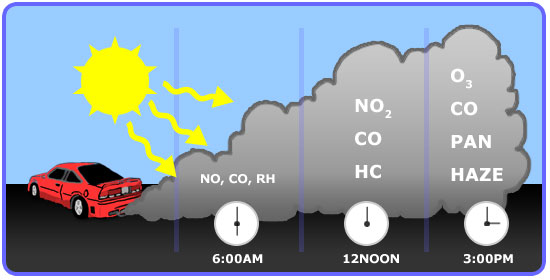Automobiles and the Environment: Understanding the Impact of Exhaust and Photochemical Smog
Introduction
The automobile, a quintessential symbol of modern civilization, has reshaped how we live, work, and travel. Since its adoption in the early 20th century, the car has not only epitomized technological advancement but also brought about significant changes to urban landscapes worldwide. However, the rapid proliferation of automobiles following World War II has introduced a less welcome phenomenon: significant environmental pollution. As urban areas expanded and became densely populated with vehicles, the hidden environmental costs of this convenience began to emerge prominently. This article explores the multifaceted impacts of automobile emissions, focusing particularly on the severe problem of photochemical smog.
Sources of Automobile Pollution
Automobile pollution primarily refers to the emissions produced by vehicle exhausts. In urban settings, it is common to witness cars emitting clouds of white or black smoke, contributing to air and noise pollution. When a ton of gasoline is combusted in an automobile engine, it releases between 10 to 70 kilograms of exhaust gases, which contain between 150 to 200 different compounds. In addition to these gases, the fuel and combustion systems can leak about 20kg to 40kg of gasoline and gas, further adding to the environmental burden. These emissions include harmful gases like carbon monoxide and nitrogen oxides, as well as particulates such as lead dust and carbon black, all of which degrade air quality and pose health risks. The presence of these pollutants underscores the urgent need for regulatory measures and technological innovations to reduce emissions from vehicles.

Understanding Photochemical Smog
One of the most hazardous outcomes of automobile exhaust is photochemical smog, primarily formed from nitrogen oxides under intense sunlight. These oxides undergo photochemical reactions to produce highly reactive free oxygen atoms. These atoms then combine with the ordinary oxygen molecules in the air to form ozone. At ground level, ozone is a potent pollutant; it reacts with hydrocarbons in the exhaust to create harmful compounds like formaldehyde, acetaldehyde, and various ketones. This complex chemical transformation results in smog that is not only a visual blight but also a serious health hazard.
The formation of photochemical smog is a dynamic and complex process, exacerbated by certain weather conditions and urban topography which can trap smog over a city, leading to prolonged exposure. Understanding the chemistry behind photochemical smog helps in devising effective strategies to combat it, such as improving fuel quality, enhancing vehicle emission standards, and promoting alternative modes of transportation.
Impact of Photochemical Smog
The implications of photochemical smog are extensive and destructive. It compromises human health, leading to increased respiratory and cardiovascular diseases. The environmental damage is also severe; during smog episodes in cities like Los Angeles, visible impacts include the discoloration of suburban vegetation and the widespread withering of trees, including pines and evergreens. Additionally, photochemical smog affects domestic animals, contributes to the deterioration of rubber products, and accelerates the corrosion and damage to buildings and monuments, showcasing its pervasive and damaging nature.
Health experts highlight that prolonged exposure to photochemical smog can exacerbate asthma, lead to the development of chronic bronchitis, and decrease lung function. This not only affects the quality of life for millions but also increases healthcare costs and reduces productivity due to illness. For the environment, the smog can reduce crop yields and degrade the quality of natural habitats, impacting biodiversity and ecosystem services. These widespread impacts make it imperative to address photochemical smog through comprehensive air quality management and pollution control strategies.
Other Toxic Emissions and Environmental Concerns
Beyond photochemical smog, automobiles emit other toxic substances, including sulfur dioxide, carbon monoxide, and lead compounds, which are directly harmful to human health. The environmental impact of automobiles also includes non-chemical pollutants; the noise, vibration, and dust raised by vehicles contribute significantly to urban pollution. These factors collectively degrade the quality of life and affect the mental and physical health of city residents, underscoring the broad and multifaceted nature of pollution associated with automobiles.
Sulfur dioxide and carbon monoxide, for instance, have immediate health implications. Sulfur dioxide can trigger asthma and other respiratory conditions, while carbon monoxide is a lethal toxin that interferes with the blood's ability to carry oxygen. Lead, once used extensively in gasoline, still poses risks due to legacy contamination even though it's less commonly used today. Moreover, the noise from constant traffic can cause chronic stress and hearing loss, while vibrations can damage structures and cause discomfort in daily living environments. Addressing these multifaceted pollution issues requires a holistic approach that includes tighter emission standards, urban planning to reduce reliance on personal vehicles, and the promotion of cleaner public transportation options.
Conclusion
While automobiles continue to be indispensable to modern society, representing a significant advancement in human mobility, they also pose substantial environmental challenges. The dual nature of automobiles as both conveniences and sources of pollution necessitates a critical reevaluation of automotive technologies and urban planning strategies. Moving forward, innovative solutions in vehicle design, fuel use, and public transportation systems are essential to mitigate the harmful effects of automobile emissions, ensuring that automobiles can continue to serve as a symbol of progress without compromising environmental and public health.
As the world progresses, the transition towards electric vehicles and renewable energy sources presents a promising pathway to reduce the environmental footprint of our transportation systems. Additionally, enhancing public transit infrastructure and encouraging non-motorized forms of transportation, like biking and walking, can significantly decrease urban air pollution. Embracing these changes not only addresses the immediate threats posed by automobile emissions but also contributes to the long-term sustainability of our urban environments, making cities healthier places to live for future generations.









